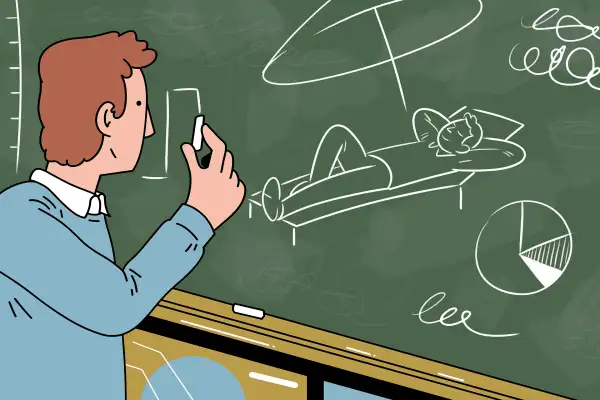3 Ways Teachers Can Get Their Retirement Savings on Track

For new teachers, saving for retirement is one among a cacophony of priorities asking for their attention at the beginning of the school year. Between building lesson plans, connecting with new students, and now keeping up with COVID-19 safety protocols, saving for a something that's thirty-plus years down the line can easily be pushed to the sidelines.
Yet understanding your options and starting to save for retirement early are key to taking care of your future self and reaching your goals later in life. Early on, waiting just a few years to start saving can cost you tens of thousands of dollars in the long term.
The vast majority of teachers have access to a pension plan, so you might think there's little for you to pay attention to. But several states have started reducing the generosity of pension benefits for incoming cohorts of teachers, and in many cases, educators may need to supplement their state retirement plan with individual savings.
Here’s what you need to know if you’re an early-career teacher looking to get your retirement saving in order.
Check if you are eligible for Social Security benefits
Unlike for those in the private sector, Social Security isn’t a given for some teachers and other public-sector employees. When the program was created in 1935, public-sector workers were excluded across the board.
That eventually changed when states were given the right to decide if they’d allow their public servants to pay into Social Security and receive coverage. Most states decided to opt in, but more than a dozen didn’t, and a few others allowed individual school districts to make the choice.
Now, around 40% of current teachers aren’t eligible for the system at all in states like Illinois, Colorado and California. Pensions in those states are supposed to make up for the missing Social Security benefits, but it’s worth knowing whether you’re paying into Social Security when you begin teaching in a state.
Social Security is a cornerstone of retirement income for many Americans because it's guaranteed for life and the benefits get an annual cost-of-living adjustment. The program has its own shortcomings, but without it, teachers in some states will need to save more to have a secure retirement.
Understand your pension — and its limitations
Pensions are also known as defined-benefit plans, meaning they operate by formulas that are based on your salary and years of service; the more years of service, the more you are entitled to receive from the pension in retirement.
Traditional pensions today replace 66% of a teacher’s salary on average, according to a ranking of teacher retirement plans from the nonprofit organization Bellwether Education Partners. That’s for those who start teaching at age 25 and retire at a normal age.
Most pensions require teachers to work in the same state for five years before they qualify for the formula-based benefits, but in at least a dozen states, that benchmark is 10 years. That means for teachers who only stay in a state or in the profession for a few years, pension payouts are minimal, if you get any at all.
If your state is one of the 36 that offers a pension plan as its default option, you don’t have to opt-in to your workplace pension — you'll be automatically enrolled — and you don’t need to make any choices about the investments you’re in.
The most important responsibility with having a pension is understanding your specific pension’s formula, says Ryan Frailich, a former teacher and now financial planner who runs Deliberate Finances in New Orleans.
“It’s worth putting those [formulas] into Excel and just showing yourself: ‘Ok, if I work 25 years here, I’m going to look at my salary scale and look at what I think I’ll be able to make in terms of what my salary could get up to and what the highest three years of average salary are going to be,'” Frailich says.
“I think that's important to inform the teacher that, hey, this is something that could potentially play a big role in [your] retirement; it could also play relatively no role at all."
Once you see how the formula will work for you, use it to make informed decisions about your future — whether that's a decision about staying in a certain state or about what else you'll need to do to increase your retirement savings.
Consider additional ways to save for retirement
Recent studies have shown as many as 40% of Americans are considering quitting their jobs a year into the pandemic, and even pre-pandemic, more than 40% of teachers left their jobs within the first five years.
If you’ve done the math and your pension likely won’t sustain you in retirement — or if you’re one of the many Americans who may switch careers or move states in the future — you’ll want to start looking at other ways to save for your later years.
One of the easiest ways to start saving on your own is to open a Roth IRA, experts say. You can open an account with a zero balance, and since you deposit after-tax dollars, any money you withdraw at age 59 ½ or older isn’t taxed.
“If you think that you're potentially going to switch jobs, or careers even, I think the Roth IRA is a great way to go,” says Scott Dauenhauer, a CFP in Murrieta, California who works exclusively with teachers.
You can also withdraw your deposits any time before that without being taxed, making Roth IRAs a good option if you want the security of being able to get your contributions back in the near term.
School districts also offer additional defined-contribution plans to teachers, typically in the form of 403(b)s or 457(b)s. These plans aren’t subject to oversight in the same way 401(k)s are, and that means it can be tricky to wade through which ones are good plans and which are riddled with high fees and other issues.
Teachers are often presented with many companies and plans to choose from, says Dan Otter, a former teacher who now runs a non-profit called 403bwise helping teachers “get wise” to the 403(b) system. He does his best to break it down on his website, where he lists “green light” and “yellow light” companies that offer low-cost investments.
“It really comes down to these companies,” Otter says. If you don’t have any of the companies Otter recommends — like TIAA, Vanguard and Fidelity Investments, for example — he’s put together a toolkit complete with slides for teachers to advocate for their employers to add a low-cost 403(b) option.
He and Dauenhauer are also developing a section of the site where they assign grades to the defined-contribution plans available at school districts around the country. (Search for the districts they've graded so far here.)
Saving for retirement as a teacher can be complicated, so seek out resources or consider hiring a financial planner to help with the process.
More from Money:
Many Teacher Pension Plans Get Failing Grade: New Report
Believing This Big Social Security Myth Could Put Your Retirement at Risk
